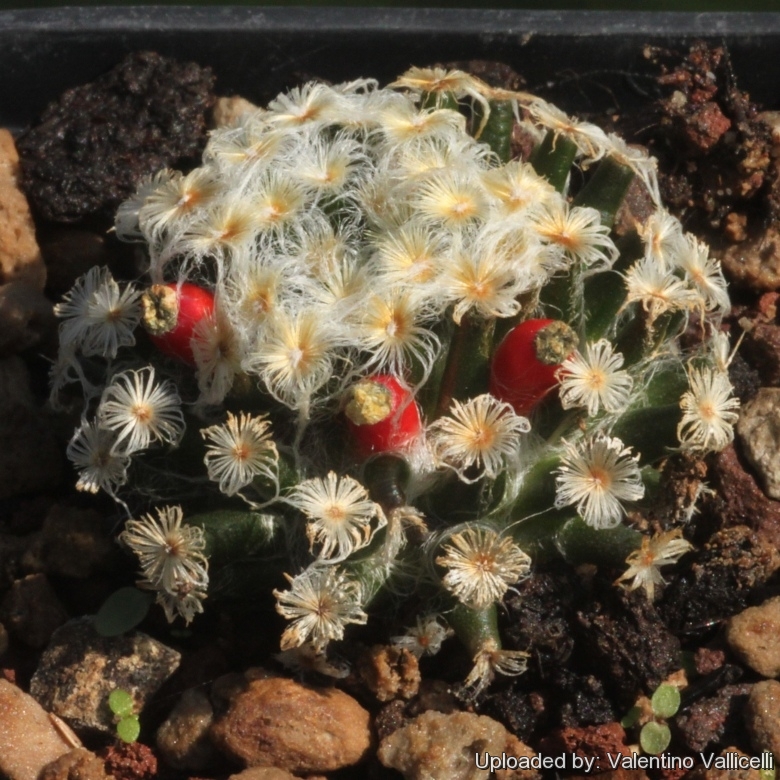
Mammillaria schiedeana var. plumosa Photo by: Valentino Vallicelli
Origin and Habitat: Unknown. The standard species is endemic to Mexico in the states of Guanajuato, Hidalgo, Querétaro, San Luis Potosí, and Tamaulipas.
Synonyms:
See all synonyms of Mammillaria schiedeana
Description: Mammillaria schiedeana var. plumosaSN|25293]]SN|25293]] is a white spined form with slightly different soft interwoven spination. It is solitary to densely caespitose. The size and shape of the stems is somewhat variable from small evenly flattened rounded tops merging together very low to the ground, to form even mounds with larger headed, separately standing stems.
Roots: Thick root.
Stem: Globular flattened, more or less rounded at the top, dark green, soft-fleshed, 2,5-10 cm tall 4 to 6 cm thick.
Tubercles: Green, close together, terete, long and thin, tapering toward the tips, without latex, 6-10 mm long; axil with long bristle-like white or yellowish hairs protruding above the tubercles or absent.
Radial spines: Very numerous 100-120 per areole, in several series, white to pale cream, spreading, fine, bristle-like, puberulent, up to 5 mm long, tips hairlike.
Central spines: 6-10, raylike and addpressed against the radials, a little stouter, feathery, yellow that turn white.
Flowers: White to cream-coloured, 8-15 mm long; inner perianth segments white; filaments white, style cream-coloured; stigma lobes 4, short, obtuse.
Blooming season: It produces ring after ring of flowers throughout most of the winter.
Fruits: Red, narrow in late summer.
Seeds: Black.
Subspecies, varieties, forms and cultivars of plants belonging to the Mammillaria schiedeana group
Bibliography: Major references and further lectures
1) Curt Backeberg “Cactus Lexicon” Sterling Publishing Company, Incorporated, 1978
2) Edward F. Anderson “ The Cactus Family” 2001
3) Hiroshi Hirao “Colour encyclopaedia of cacti” Japan 1979 (Japanese language and script)
4) Willy Cullmann, Erich Götz (Dozent Dr.), Gerhard Gröner “The encyclopedia of cacti” Portland, OR: Timber Press, 1986
5) David Hunt, Nigel Taylor “The New Cactus Lexicon” DH Books, 2006
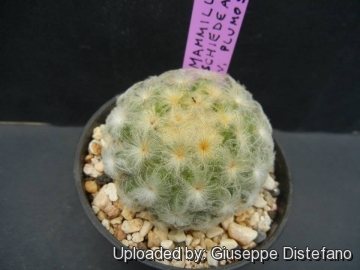 Mammillaria schiedeana var. plumosa Photo by: Giuseppe Distefano
Mammillaria schiedeana var. plumosa Photo by: Giuseppe Distefano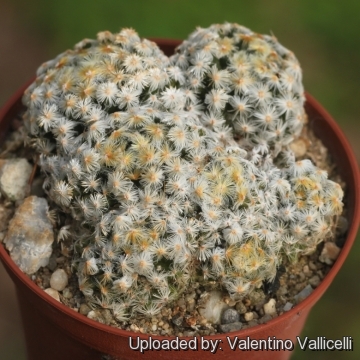 Mammillaria schiedeana var. plumosa Photo by: Valentino Vallicelli
Mammillaria schiedeana var. plumosa Photo by: Valentino Vallicelli Mammillaria schiedeana var. plumosa Photo by: Valentino Vallicelli
Mammillaria schiedeana var. plumosa Photo by: Valentino Vallicelli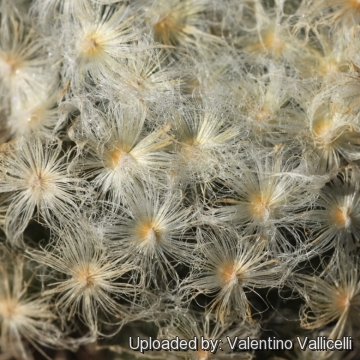 Mammillaria schiedeana var. plumosa Photo by: Valentino Vallicelli
Mammillaria schiedeana var. plumosa Photo by: Valentino Vallicelli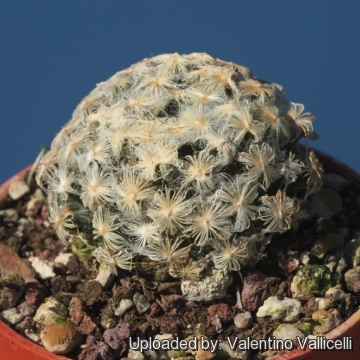 Mammillaria schiedeana var. plumosa Photo by: Valentino Vallicelli
Mammillaria schiedeana var. plumosa Photo by: Valentino VallicelliSend a photo of this plant.The gallery now contains thousands of pictures, however it is possible to do even more. We are, of course, seeking photos of species not yet shown in the gallery but not only that, we are also looking for better pictures than those already present.
Read More... Cultivation and Propagation: It is relatively rare in cultivation and has the fame to be difficult to grow on its own roots because it is sensitive to overwatering (rot prone) and slow-growing and requires skilful cultivation.
Soil: Grow it in an open sandy-gritty cactus compost.
Pots: It needs a relatively shallow pot to accommodate its fibrous roots and provide a very good drainage. They may stay in the same pot for many years.
Watering: Water in moderation, it prefer a completely dry place during winter. Mature individuals easily rot and die especially after planting so be extremely cautious with watering. Keep dry in winter or when night temperatures remain below 10° C. Water it less than average if in bigger pots.
Special need: Provide very good ventilation. Nearly all problems occur as a result of overwatering and poor ventilation, especially when weather conditions are dull and cool or very humid.
Fertilization: Feed them once during the growing season with a fertilizer specifically formulated for cactus and succulents (high potash fertilizer with a dilute low nitrogen), including all micro nutrients and trace elements diluted to ½ the strength recommended on the label. They thrive in poor soils and need a limited supplies of fertilizer to avoid the plants developing excess vegetation, which is easily attacked by fungal diseases.
Exposure: It will do its best with lots of sun and become stressed with inadequate light which could result in poor growth and unnatural shape.
Hardiness: It likes warmth (recommended minimum winter temperature 5° C) however plants kept perfectly dry can can survive low temperatures, approx. -5°, but for safe cultivation it is best to avoid freezing temperatures.
Use: This is a good pot plant suited for a non heated green house. It can be also cultivated outdoors in raised beds, terraces if sheltered from winter rain. This cactus continues to be, a particular prize among collectors
Pests & diseases: These cacti may be attractive to a variety of insects, but plants in good condition should be nearly pest-free, particularly if they are grown in a mineral potting-mix, with good exposure and ventilation. Nonetheless, there are several pests to watch for:
- Red spiders: Red spiders may be effectively rubbed up by misting the plants from above.
- Mealy bugs: Mealy bugs occasionally they develop aerial into the new leaves and flowers with disfiguring results, but the worst types develop underground on the roots and are invisible except by their effects.
- Scales, thrips and aphids: (they are rarely a problem.)
- Rot: Rot is only a minor problem if the plants are watered and “aired” correctly. If they are not, fungicides won't help all that much.
Propagation: Seeds are quite difficult to germinate and a low rate of success. The seeds can be sown in pots of fine, well-drained sandy soil, any time during the spring when temperatures are warm. Cover the seeds with a fine layer of grit and water from below with a fungicide to prevent damping off. For the 1-2 weeks cover the pots with a sheet of glass/clear perspex to keep the humidity levels high. Remove the glass and replace it with light shade-cloth and mist once or twice a day for the next two weeks after which most seeds should have germinated. From then on mistings can be reduced to every second and then every third day as the little plants grow. Grafting is often used to speed growth rate and to create a back-up for plants in collection.
















